

May 2022
|
Search the FOA website
FOA Home Page
Contact
Us
|
Sign
up for the FOA eMail Newsletter
Privacy Policy
Sections
News
Technical
Worth
Reading Q&A
Training/FiberU
Resoures
Safety
About
|
- Note we have
changed the format to place articles in
sections on one topic and all articles are
dated so you know if we repeat one - which
we often do when we think it's very
important!
Fiber U And What It Can Do For You
Pole Stories
Who's Responsible For The Pole
Reuse Or Recycle Fiber Cable
Fiber Project Timeline
Resources For Broadband
More About FTTH & Rural Broadband
Newsletter Sections
Click
on any link to jump to that section
News
UK Project To Install Fiber In Water Pipes
Building Longest Submaring Cable
AT&T Says Goodbye To Copper, Hello To Rural FTTH
California Chooses Utopia For Rural Projects
Fiber Project damages Gas Pipe In Texas
Got An Idea For A New Fiber Tool?
Technical
Useful New Products
Measuring Loss - dB Again
Warning For Techs About Fiber Amplifiers
FOA Online Loss Budget Calculator
Worth
Reading Lots of interesting
articles
Q&A
Questions from our readers
Training/FiberU
Beware Of Fake FOA School, New FOA-Approved Schools, Fiber U
MiniCourses, making training classroom safe, onine
training, materials, more
Resources
New FOA YouTube Videos. Safety
About
FOA Certifications:
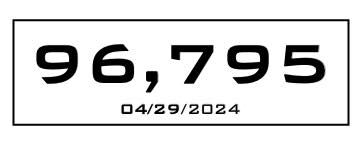
Time
To Renew Your FOA Certifications?
Special offer - 1/3
Off Renewal
Jobs
- See FOA Jobs
Web Page and FOA on

- The FOA Jobs
Web Page has been updated and a new page added
on Using your FOA
Training/Certification to Find the Right Job
in Fiber Optics
Where
Are The Jobs In Fiber Optics? FOA talks about
all the applications for fiber optics, what jobs
involve and the qualifications for the workers in
the field in this YouTube video.
Join The FOA eMail Newsletter
List
Want
to be notified when the FOA Newsletter is updated? Sign
up for the FOA eMail Newsletter. You can
also sign up from your cell phone: text "FOA" to
22828 (usual text message charges apply)
Trademarks:
The FOA CFOT® (Certified Fiber Optic Technician) and
Fiber U® (the FOA online self-study program) are
registered trademarks of the FOA.

Want to know more about fiber optics? Study
for FOA certifications? Free
Self-Study Programs are on "Fiber U®."
Looking for specific information? Here's the largest
technical reference on the web: The
FOA Online Fiber Optic Reference Guide.
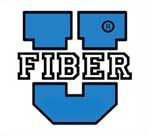
Free online self-study programs
on many fiber optics and cabling topics are
available at Fiber U,
FOA's online web-based training website.
FOA
Reference Books
Available Printed or eBooks
The fiber book is
available in Spanish and French
  

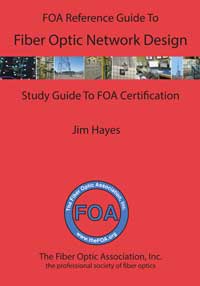 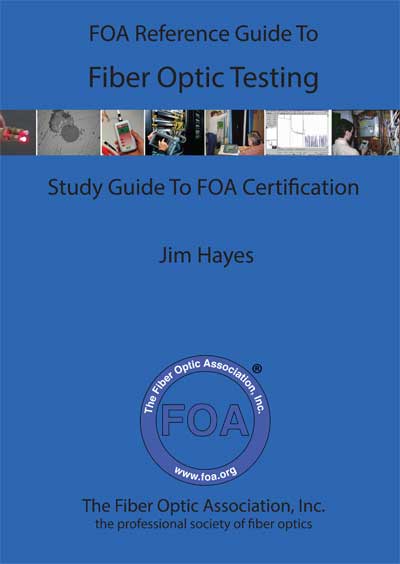
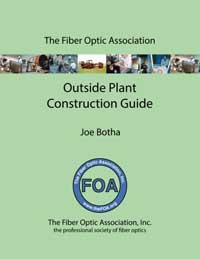 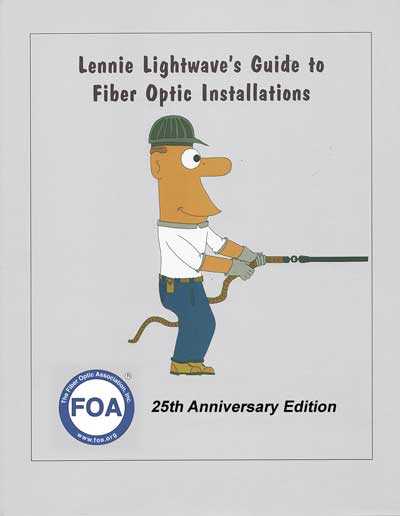
Lennie
and Uncle Ted's
Guides are now also available as free iBooks on
iTunes.
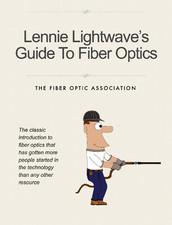
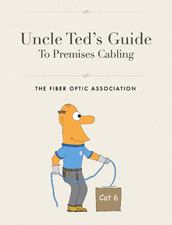
Click on any of
the books to learn more.
- Fiber
Optic Safety Poster to download and
print
FOA Videos on 
FOA
is a member of:




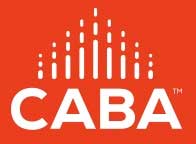
The FOA Newsletter is
edited by Jim Hayes - send your stories, leads,
ideas, comments to <jim @ foa.org>

Search the FOA Website With
DuckDuckGo
Top Stories From The 2021 FOA Newsletters
- The Archives: Past
Issues.
- Use these links to
read past issues or use FOA's
Custom Search to look for specific
topics on our website.
1/22, 2/22, 3/22, 4/22, 5/22,
1/21, 2/21. 3/21, 4/21, 5/21, 6/21, 7/21, 8/21, 9/21, 10/21,
11-12/21,
1/20,
2/20,
3/20.
4/20,
5/20,
6/20,
7/20,
8/20,
9/20,
10/20,
11/20,
12/20,
1/19,
2/19,
3/19,
4/19, 5/19, 6/19, 7/19, 8/19, 9/19,
10/19,
11/19,
12/19
1/18,
2/18,
3/18, 4/18,
5/18, 6/18, 7/18, 8/18, 9/18, 10/18,
12/18.
1/17, 2/17, 3/17, 4/17, 5/17, 6/17,
7/17,
8/17,
9/17,
10/17, 11/17,
12/17
1/16, 2/16, 3/16,
4/16,
5/16,
6/16,
7-8/16,
9/16,
10/16,
11/16,
12/16
1/15,
2/15,
3/15,
4/15,
5/15,
6/15,
7/15,
8/15,
9/15 ,
10/15,
11/15
, 12/15
1/14,
2/14,
3/14,
4/14,
5/14,
6/14,
7/14,
8/14,
9/14,
10/14,
11/14,
12/14
1/13,
2/13,
3/13,
4/13,
5/13, 6/13,
7/13,
8/13,
9/13,
10/13,
11/13,
12/13
1/12
, 2/12,
3/12,
4/12,
6/12,
7/12,
8/12,
9/12,
10/12,
11/12,
12/12
1/11 ,
2/11,
3/11,
4/11,
6/11,
7/11,
8/11,
9/11, 10/11,
11/11,
12/11,
1/10 ,
2/10,
3/10,
4/10,
05/10,
07/10,
08/10,
09/10,
10/10,
11/10
1/09 ,
2/09,
3/09,
04/09,
05/09,
07/09,
08/09,
09/09,
10/09, 11/09,
12/09
1/08 , 2/08, 3/08, 4/08, 5/08, 6/08, 7/08, 8/08, 09/08, 10/08, 11/08, 12/08
12/07 , 11/07, 10/07, 09/07, 08/07, 07/07, 06/07, 05/07, 04/07, 03/07, 2/07, 1/07
12/06 , 11/06, 10/06, 09/06, 8/06, 7/06, 6/06, 5/06, 4/06, 3/06, 2/06, 1/06,
12/05 ,11/05, 10/05, 09/05, 08/05, 07/05, 6/05, 5/05, 4/05, 2/05, 01/05,
12/04 , 10/04, 9/04, 8/04, 7/04, 6/04, 5/04, 4/04, 3/04, 1/04,
12/03 , 11/03 10/03 9/03, 8/03, 7/03, 6/03, 3/03, 10/02 , 8/02, 5/02
Current Issue of FOA
Newsletter
Time To Renew Your
FOA Certifications?
To
keep your FOA certifications active, you need to
renew them when they expire. Now we have a new more
convenient way to renew - an online store at Paypal
- where you can quickly and conveniently use your
PayPal account or your credit card to renew your
certifications.
- You can now renew
with PayPal or a credit card
-
PayPal is available worldwide
Join FOA On
Social Media

FOA
has 3 LinkedIn Groups
FOA
- official page on LinkedIn - covers FOA, technology and jobs in the fiber optic
marketplace
FOA
Fiber Optic Training - open to all, covers
fiber optic technology and training topics
Grupo
de La Asociación de Fibra Óptica FOA (Español)
|
FOA Newsletter -
All About Fiber U And What It Can Do FOR YOU!

Readers of the FOA Newsletter are always seeing references to Fiber U,
FOA's popular free online learning site. Many of you are already using it and
know it well, but we thought a introduction might be in order for those
of you who have not used it and even introduce new possibilities to
those of you who use it now.
What Is Fiber U?
Fiber U is a online learning site that provides free online self-study
courses. The first Fiber U was created in 1997 by a Boston schoolteacher
working with us as a summer intern. He had created some of the very
first online courses for the Boston teachers using a simple model - classroom
course lesson plans.
He started with a lesson plan that organized the content of the course
and ended with a quiz to allow the person taking the course to test
their comprehension. While a classroom course would use a printed lesson
plan and textbooks with a quiz handed out by the instructor, he set up
the course online. The "lesson plan" was the home page, with each
section of the lesson linking to another web page with the technical
content to study. After finishing the lesson, there was a link to a quiz
on the material with answers available after finishing it.
 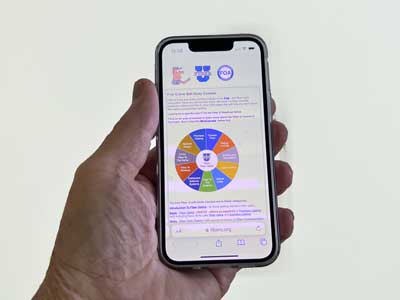
Fiber U started so long ago that Lennie Lightwave was using an original iMac. Today it runs on any device.
Almost 25 years later, today's Fiber U works just about the same way;
only the software for creating the online material is more
sophisticated. And of course the number of subjects available have
increased, based on the almost 1,000 pages of technical reference
material in the FOA Guide and more than 100 videos on YouTube. We even provide links to the FOA printed textbooks, if you prefer the printed page.
Today Fiber U offers more than two dozen free courses on a full range of
topics covering fiber optics and premises cabling and we're adding more
all the time. FOA offers tests for a Certificate of Completion allowing
course takers to get a permanent record of their successfully
completing the course for a nominal fee, perfect for adding to your
resume.
How Can You Use Fiber U?
The most popular use of Fiber U is for an individual to want to learn
more about a particular subject, say FTTH, OTDR testing or midspan
access. They can take the course and check their comprehension with the
free quizzes for each lesson section, then decide if they want the
Certificate of Completion. Having a Fiber U Certificate of Completion is
widely recognized as a sign of competence, good for the resume when it
comes to employment searches or impressing customers.
Blended Learning Courses
Schools can use Fiber U for what's called "blended learning." During the
pandemic, many of the FOA schools required their class attendees to
take Fiber U courses to reduce the time spent in the classroom, instead
spending most of the time in hands-on labs developing skills. Blended
learning can be either independent, where the student completes the
class on their own with the instructor available for questions by email,
or it can involved instructor led sessions using video conference
services like Zoom.
Prepare For FOA Certification Exams
Fiber U offers courses aligned toward FOA certifications, so if you are
preparing to take the FOA certification exams or just
getting ready to take a course from one of the hundreds of FOA approved
schools, Fiber U provides a free way to prepare for taking the FOA
certification exams. The materials covered are the same, so you know you
will be studying the right technical materials.
OJT to
Cert And Work to Cert Programs
The FOA Work to Cert program for experienced fiber techs uses the Fiber U
Basic Fiber Optics course to prepare techs for taking the CFOT exam.
The FOA OJT to
Cert program for newcomers doing on-the-job training (OJT) with a
contractor also uses this program, starting with the basics then
advancing to other topics that are relevant to their work on the job.
Programs For Companies
Companies and contractors have really been using Fiber U for OJT and
Work to Cert programs. FOA has worked with several to create structured OJT
programs for their employees - not just newcomers but experienced fiber
techs looking to grow professionally - that lead them through a series
of courses to improve their knowledge and work skills.
Remember the online courses at Fiber U are free; just a nominal charge
for using our online testing service to get a certificate of completion.
We've also made
arrangements with contractors to allow employees to take free
Certificate of Completion tests and we bill the contractor directly.
How can Fiber U help you and your company? Ask the FOA.
Fiber U Adds More Free Online Self-Study Programs including Basic Fiber Optics in Spanish.
More Pole Stories And Photos
Sharp-eyed FOA Instructor Milt Murry keeps sending us photos from his
neighborhood in St. Louis. From these photos, we wonder if the local
owners of the utility poles always does their pole replacement with a
chain saw.
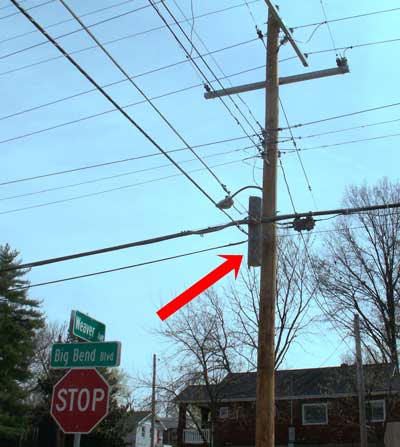
This is not the first time we've run photos from Milt showing poles with
a sawed-off piece of pole left hanging. At least in this case, they
appear to have attached it to the new pole, unlike the earlier ones
where they left it hanging from the messenger.
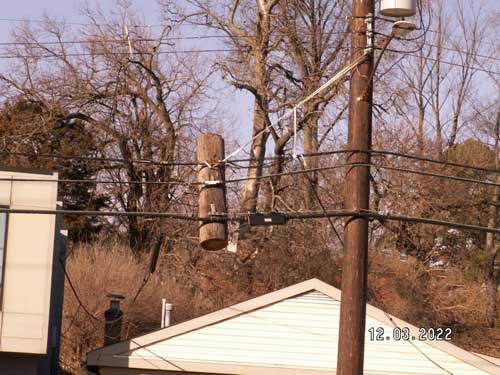 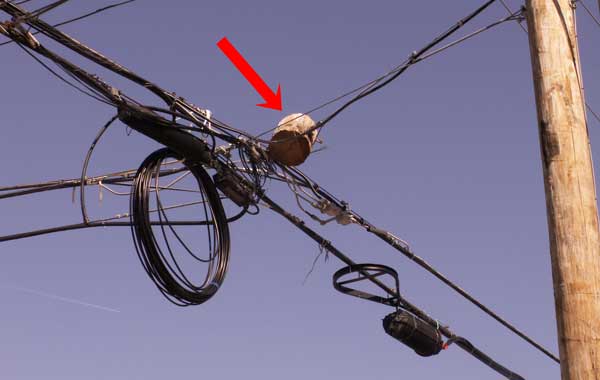
There appears to be a crew in St. Louis that finds this workmanship
acceptable. And a company that accepts it on their cable plants. We're
left speechless.
Pole Replacement Done Right
We've run photo stories of pole replacement in our neighborhood in Santa
Monica, CA (above), and we can attest to the fact that the workmanship
is first rate. They have replaced most of the poles in the alley behind
our building and the process is fascinating. They shut the power off,
support the wires using bucket trucks and temporary supports, unbolt the
hardware from the pole and pull the pole from the ground with a big
crane.
Installing the new pole reverses the process and all the wires go on new
hardware. The entire process for a pole takes less than 8 hours and
when they are finished, it's hard to tell any work was done at all - it
looks just like it did before, just a bit neater.
Here is a photo from April 5, 2022 at the end of our alley:
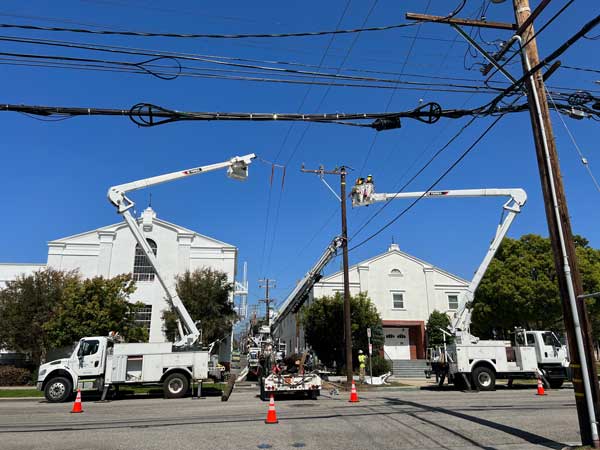
We've watched and photographed these replacements so many times, the
crews from Southern California Edison remember us. We introduce
ourselves and the FOA, offering them information on fiber optics. On
this day, one of the guys we've introduced to fiber, Juan, wanted to get
his photo taken with us.
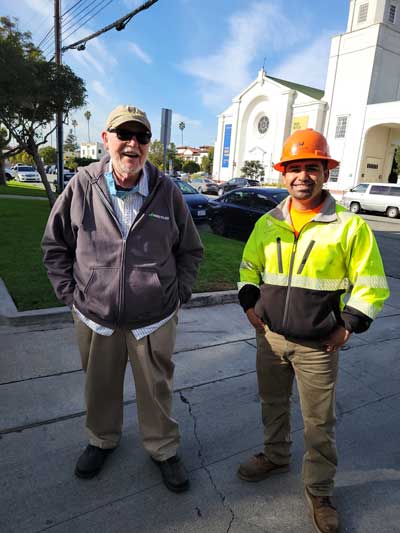
If A Pole Problem Exists, Who's Responsible?
When you have many users on a single utility pole, it can get
interesting trying to get it fixed because you first have to find out
who is responsible for the problem. A recent article in the Washington
Post by Columnist John Kelly titled "When it comes to utility wires and boxes, companies pass the buck."
It started when a cover panel fell from a utility box on a pole in Mr.
Kelly's neighborhood in Silver Spring, MD, a suburb of Washington, DC.
It sat on the ground for weeks while Mr. Kelly tried to find who was
responsible for it. Unfortunately, the panel itself had no
identification marks.
The person at the house where the panel fell had called PEPCO, the local
power utility. It was not theirs but they did put a warning label on
it.
The reporter contacted the Maryland Public Utility Commission who said
PEPCO probably owned the pole. So the reporter also called PEPCO and
asked if they knew who owned the equipment since it was their pole. They
did not.
PEPCO suggested he call the county. They did not know either, but was
able to give him numbers of companies that might own the equipment:
Verizon, Comcast, RCN and DirectTV.
So follow this closely: Verizon looked at a photo and said it was a
Comcast box. Comcast came to the site to examine it and said it was not
theirs but was probably a Verizon or RCN box. DirectTV said it was
not theirs and contacted AT&T to determine it was not theirs
either.
Next the reporter called Montgomery County's Office of Consumer
Protection which passed him along to the county Office of Broadband
Programs. They sent a crew over which inspected the box and said it was
an old RCN power supply. They wrote up an alert to RCN. When the
reporter called RCN, they already had the alert and had created a repair
ticket. The next day it was fixed.
This Is A Problem
This is a consistent problem with aerial cables and equipment. Too many
users, no point of contact. The workmanship we see on poles now is
abominable. And remember now we now have "One Touch Make Ready" so who
knows what can happen.
Recycle Or Reuse Fiber Optic Cable?
A subject that comes up occasionally is whether fiber optic cable can be
reused or recycled, or if there is a market for cable that is old or
damaged. The most recent call was from an environmental consultant. Another
call was from an insurance company with a large stock of data center cable involved in a flood while awaiting
installation.
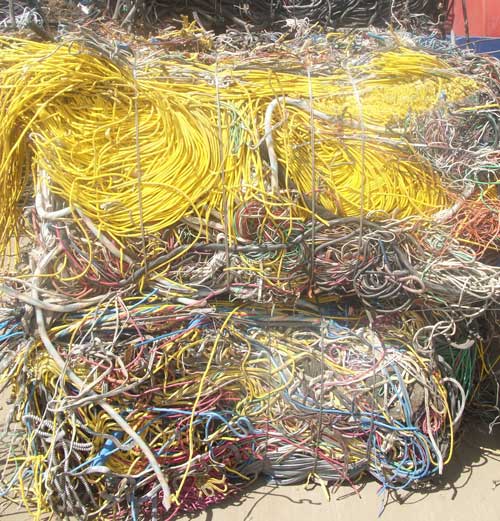 This is a matter of concern because there is a lot of scrap cable
leftover from new installations and some old cable removed to install
new cable. Much of this cable ends up in landfills, which creates a
problem. Since fiber optic cable is engineered for a long lifetime, 40
years or more, it does not decompose in a landfill in a reasonable time.
That creates a problem for landfills. This is a matter of concern because there is a lot of scrap cable
leftover from new installations and some old cable removed to install
new cable. Much of this cable ends up in landfills, which creates a
problem. Since fiber optic cable is engineered for a long lifetime, 40
years or more, it does not decompose in a landfill in a reasonable time.
That creates a problem for landfills.
Proper design can reduce the excess cable leftover from new projects,
and some of the cable should be stored for emergency restorations.
Lengths over 1 km may be of interest to brokers who resell cables.
The question of reusing fiber optic cable is easy to answer. Practically
no OSP fiber optic cable is removed unless it it old and obsolete or
damaged and ready for disposal. Premises cable might be removed as part
of a network upgrade, but that means it's probably obsolete and the
chance of damage in removal is very high. (Most cable removed is cut
into smaller lengths to simplify removal anyway.)
Even older fiber optic cable that has just been in storage is hard to
sell in our experience. The questions raised include the manufacturer
and the date of manufacture, the type and manufacturer of the fiber in
the cable, how the cable has been stored and if there is recent
test data. We are aware of several offerings of older cable but are not
aware of any of it being sold and installed. Does anybody know of any
deals like this?
There is also the issue of economics. How much can you save on cheap
cable when the cable is a small fraction of the total cost of the cable
plant? Installation is the largest cost, of course. Why be "penny wise
but pound foolish" as the old saying goes?
The idea of recycling is also problematic. Unlike a drink bottle, a
fiber optic cable is not all one type of plastic. Typical OSP cable
construction includes a center fiberglass rod, surrounded by buffer
tubes full of fiber - and usually dry or gel water blocking compound -
wrapped in aramid fiber strength members, then a PE jacket and perhaps a
metallic armor and another jacket. It's hard to conceive of a way to
separate the different components so you could recycle some of the
plastic. Even chopping it up to use as filler in certain plastic
products is hard. Imagine trying to chop a cable into bits with the
aramid fiber strength members in the cable.
One company has developed a method of recycling old fiber optic cable
into filler for items like plastic planks used for building or gardens and shipping pallets. Steve Maginnis of LD4Recycle/ CommuniCom Recycling
has developed a proprietary process and the machinery that can reduce
fiber optic cable to a filler that can be used in these artificial wood
products. (If you have cable that needs recycling, contact
Steve at sm@LD4Recycle.com or 1-803-371-5436.
The second call we got recently was different. An agent for an
insurance company wanted to know if there was a market for a large batch
of cables awaiting installation in a hyperscale data center that was
involved in a flood caused by a water main breakage. Only a small number
of cables got wet, but the whole lot - more than $5 million in cables -
was declared a total loss. The agent wondered if there was a market for
this cable.
If you are interested in this large lot of cables, contact Mark Brown, Greer & Kirby, 714-329-2476 or mbrown@greerandkirby.com.
FOA generally tells these callers that there is not a big market for
selling such cables, although eBay lists thousands of spools of fiber
optic cable of all varieties. About the only other use we recommend is
giving the cable to a training organization like one of the FOA schools
who can use it in their hands-on labs. Over the years, FOA schools have
accepted gifts of lots of cables for this use.
A fiber optic project can be broken down into stages - planning, design,
installation and operation - with various subtopics like the ones shown
below. These stages operate in overlapping time frames and will have
different timing depending on the size and complexity of the project
plus a number of issues that can occur at various stages.
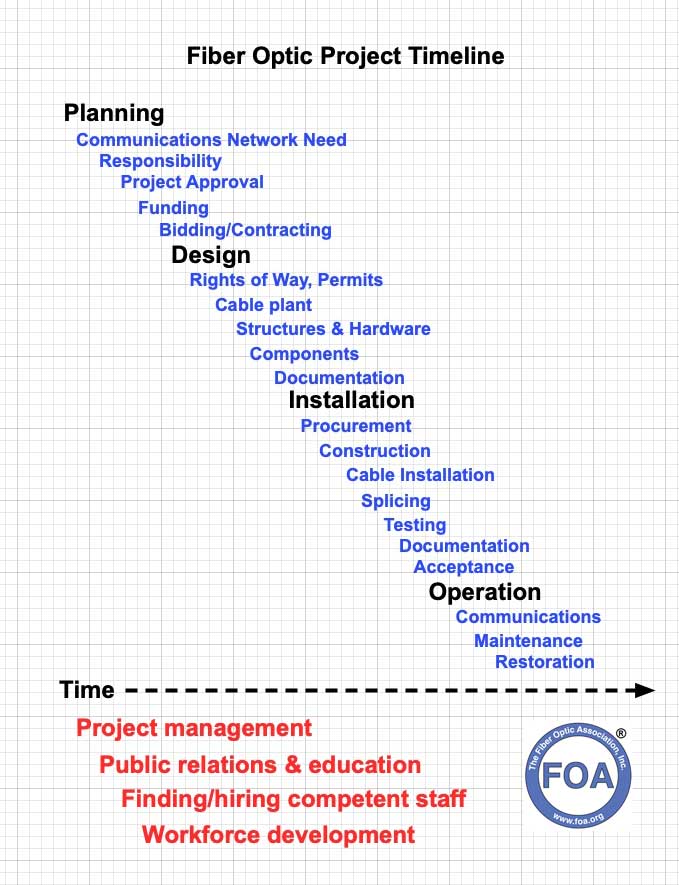
The FOA Guide To Fiber Optic Projects includes this timeline and comments on project planning and implementation.
More Resources For FTTH And Broadband From FOA
FOA has been running frequent articles on broadband project funding and planning, three in the last newsletter alone:
- Broadband Funding Information From The Source
- Biden Administration Releases Guidebook on Infrastructure Law Implementation (3/22)
- Pew Charitable Trusts' Broadband Education and Training Initiative Helps States Increase High-Speed Internet Access
We're now putting all these resources into some pages devoted specifically to to broadband projects:
FOA Broadband Pages
Many projects are being planned using the new US Infrastructure
Investment and Jobs Act (IIJA). The FOA has a page devoted to
understanding the IIJA and how to obtain help in planning and funding
broadband projects. FOA Broadband Planning Page.
FOA Reference Page On Rural Broadband
is intended to be a reference guide for those looking for more
information on rural broadband and FTTH. It includes some basic
information about rural broadband and gathers up links to the many
articles FOA has done on the topic, the FOA Guide pages on broadband and
FTTH.
The Fiber U FTTH/Broadband self-study course
is free and you can get your certificate of completion free too. This
is a good way to learn about FTTH technology for broadband.
Video Lecture: FOA Lecture 70 Rural Broadband, Obstacles And Opportunities,
Both the video lecture and the reference page are also intended for
those trying to get a project started to have a link for others
interested in the project to learn more about what is involved.
Read more about the FOA's FTTH
technical information updates
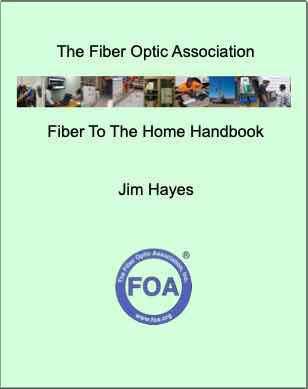
The Fiber Optic Association
Fiber To The Home Handbook is
available from Amazon in print ($19.95) and
Kindle ($9.95) editions.
More about FTTH from the FOA Newsletter
June 2021 - FTTH Special Issue (FTTH Tech Update covering new equipment and network architectures for rural FTTH.
August, 2021 - Rural FTTH Special Issue
March 2022 Is Rural Only Farms?
February 2022 Helping Make Rural Broadband Possible - New FOA Technical/Educational Materials For Those Planning Rural Broadband
January 2022 - California Announces 18 Middle Mile Projects To Bridge Digital Divide (mostly rural)
November/December 2021 - Fiber To The Village in Nepal, $Billions For Broadband In US (But don't hold your breath!)
July 2021 - Broadband Internet in California, California Broadband Council report
March 2021 - Can Tapping Fiber Reduce Cost? How Many Fibers? Optimal cable Size.

The Fiber Optic Association
Fiber To The Home Handbook is
available from Amazon in print ($19.95) and
Kindle ($9.95) editions.
FOA Newsletter
Sections
News
Technical
Worth
Reading Q&A
Training/FiberU
Resoures
Safety About
|
News
Lots more news
in Worth Reading below
|
‘Fibre In Water’ to deliver high-speed broadband in Yorkshire
A trial project in the North of England
aims to deliver gigabit broadband connections to rural communities by
feeding fibre optic cable through their water pipes. The ‘Fibre In
Water‘ scheme aims to connect an estimated 8,500 homes and businesses
through 17 kilometres of live drinking water mains. The project to provide broadband through water pipes could go live as early as 2024.
Digging up roads and installing new infrastructure can make up as much
as four-fifths of the cost of a traditional gigabit broadband network,
and can cause disruption to local communities. The Fibre In Water scheme
hopes to demonstrate a greener, quicker and more cost-effective way of
connecting fibre-optic cables, organisations involved in the project
told Tech Monitor.
The ‘Fibre In Water’ network will be used to connect 5G masts to bring
fast and reliable wireless broadband to hard-to-reach communities where
wired solutions are too expensive to deliver commercially. “We’re
committed to getting homes and businesses across the country connected
to better broadband and this cutting-edge project is an exciting example
of the bold measures this government is leading on to level up
communities with the very best digital connectivity,” said digital
infrastructure minister Julia Lopez.
The trial is the first of its kind in the UK and could lead to new
gigabit connections in people’s homes as soon as 2024. If successful,
the project could be replicated in other parts of the country, according
to the Department for Digital, Culture, Media & Sport (DMCS). This
could assist the government’s £5bn Project Gigabit,
cited as the biggest broadband roll out in British history, which aims
to provide gigabit connections to millions of rural homes and businesses
that would otherwise have higher costs of connection.
Read more in Tech Monitor
Consortium Begins Construction Of Longest Submarine Fiber Optic Cable
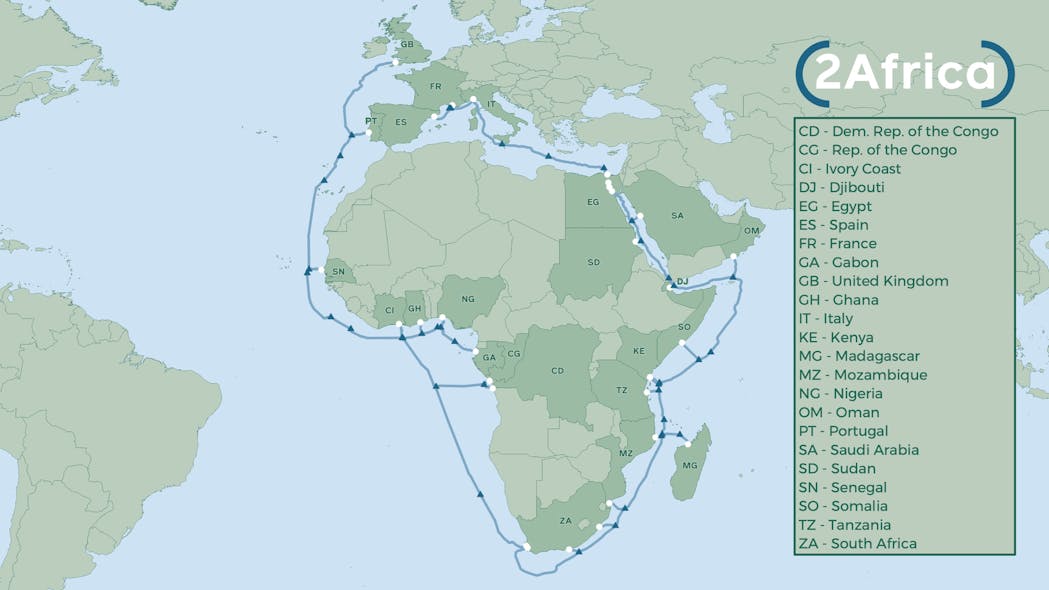
The 2Africa consortium has announced that the 2Africa submarine cable
has made its first landing, in Genoa, Italy. Upon completion in 2024,
the 45,000-km submarine network is expected to be the longest in the
world, connecting 46 locations in Africa, Europe, and Asia. China Mobile
International, Meta, MTN GlobalConnect, Orange, stc, Telecom Egypt,
Vodafone and WIOCC announced plans for 2Africa in May 2020 to connect 23
countries in Europe, Africa, and the Middle East.
Read more in Lightwave.
Also see 2022 Submarine Cable Map depicts 486 cable systems and 1,306 landings that are currently active or under construction. Telegeography.
Kentucky’s Oldham County taps AT&T for FTTP
AT&T has been selected by a county in north
central Kentucky to build a fiber to the premises (FTTP) network that
will connect every home and small business within the county lines. The
FTTP project will cost approximately $33 million and reach more than
20,000 customer locations. AT&T will own and operate the network
AT&T will use the FTTP infrastructure to offer symmetric broadband
services of up to 5 Gbps. The service provider says that it has begun
planning and engineering work and expects to begin offering services in
parts of the county next year.
"Fiber-optics are essential to delivering a long-term solution for
businesses and residents of Oldham County, and AT&T's experience and
ability to operate and maintain these complex networks is critical to
developing economic and educational opportunities in the county,"
commented David Voegele, Oldham County Judge Executive.
Stephen Hardy, Lightwave
Editorial Comment: What a difference time makes - and maybe
unloading an ill-fated investment in the entertainment business. It was
not long ago that AT&T CEO John
Stankey told Wall St. analysts that he doesn't think there is any way
to extend fiber to rural areas at all. And then, there is the article
below where AT&T abandons DSL. Also note the cost of this project-
$33million for 20,000 customers is just about right for rural networks:
~$1675 per
connection.
AT&T Says Good-bye To Copper (4/22)
On October 1, 2020, AT&T announced it would no longer offer DSL services, relying on fiber and 5G wireless instead.(FOA Newsletter)
That was understandable, not just because of the limitations of DSL,
but the company had fewer than 500,000 DSL customers, down almost 40%
for two years before.
At the company's Analyst and Investor Day Webcast
on March 11, 2022, the focus was on fiber and 5G, with plans to expand
the fiber to more than 30 million locations, including 5 million
business locations, by 2025, double the number in 2021. As more
network traffic moves to fiber and 5G, AT&T expects to drive
significant savings by reducing the company’s legacy copper footprint.
By 2025, AT&T expects that 75% of its network footprint will be
served via fiber and 5G and that it will have reduced its copper
services footprint by 50%.
AT&T has created a FAQs page
(frequently asked questions) about the phase out of copper called
appropriately enough "AT&T copper network retirement We’re replacing our traditional copper-wire network with fiber optic technology."
Perhaps the best news is buried in this quote from the webcast: “Now that the close of the WarnerMedia deal is approaching, we are near the starting line of a new era for AT&T,”
said John Stankey, AT&T chief executive officer. “The
transformation we’ve undergone over the past 18 months while delivering
outstanding operational results has brought us to this point. We will be a simpler, more focused company with the intent to become America’s best broadband provider. We plan to ramp up investment in our key areas of growth — 5G and fiber.
Investment in the network at AT&T will be more than $20 billion per year!
Welcome back to telecom, AT&T. Hollywood ain't what it's cracked up to be, eh?
Read the entire AT&T Analyst and Investor Day Webcast
California Chooses Utopia To Build Rural Fiber Networks
The Golden State Connectivity Authority (GSCA) has chosen the
municipally-owned open access network UTOPIA Fiber to design, build, and
operate a new open access fiber-to-the-home (FTTH) network across the
38 rural counties in the state of California. It's a move that not only
offers the chance to bring future-proof connections to millions of rural
California households in the near future, but have wide policy and
industry implications for open access fiber networks down the road.
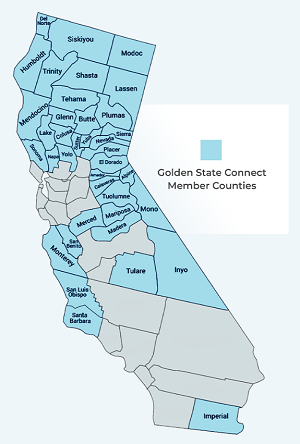
The Golden State Connectivity Authority is a joint powers authority
(JPA) created by the Rural County Representatives of California (RCRC),
which represents more than three dozen rural counties across the state.
RCRC seeks to tackle the variety of shared problems that the state's
rural communities face by advancing concrete policy solutions across
transportation, energy, natural resources, governance, healthcare, and a
collection of other arenas.
The Golden State Connectivity Authority is one of its most recent
projects, and explicitly aims to improve Internet access via municipal
solutions. Its mission is to "assist rural counties in identifying
pathways for development of internet infrastructure within their
communities, including the construction of municipal-owned and/or
operated internet systems, among other options."
GSCA leverages the collective power of the RCRC membership for financing
efforts, to go after state and federal funds, and to combine the
efforts of bringing together leadership to bridge the digital divide for
Californians living outside of urban areas. RCRC member counties
constitute about 14 percent of the state's population, or about 2.1
million households.
ILSR Community Networks
Fiber Optic Cable Installation Dig-Up Causes Gas Leak In Rural Texas
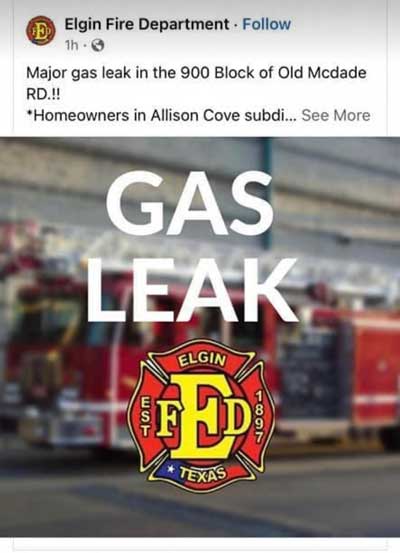
Elgin is about 20 miles (30km) East of Austin. The FOA contributor was
one of the people warned to evacuate. Because of the evacuation, we got
no photos of the incident.
FOA Had A BUSY 2021
Below is a summary of some of the FOA accomplishments from 2021:
Top Stories From 2021 FOA Newsletters
Last Gasp For Multimode Fiber?
Who Lost Lucent? The Decline of America's Telecom Industry.
Things To Learn From A Town That Voted Down Fiber.
Can Tapping Fiber Reduce Cost?
How Many Fibers? Optimal cable Size.
Women Installers In Alaska.
FOA OJT To Cert Program.
FTTH Month - June FOA Newsletter.
Building Rural FTTH - Learning From The History Of Rural Electrification.
New FOA Guidelines For Training And Certification.
Warning For Techs Doing Restoration (Fiber Amplification).
New Pages In The FOA Guide
Fiber Optic Sources For Transmitters.
Midspan Access.
Loss Budget Calculator - Online.
FTTH Network Design. (plus updated pages in the FTTH section)
New Fiber U Courses
Fiber Characterization.
Basic Fiber Optics in Spanish
FTTH Update (Get the Certificate of Completion Free!)
Loss Budgets
How Fiber Works
Fiber Optic Color Codes
Reference Cables For Fiber Optic Testing
Basic Skills Labs - Link Demos
New FOA Publications
FOA FTTH Handbook.
New YouTube Lectures
FOA Lecture 61 Fiber Optic
Color Codes
Lecture 63 FTTH Network
Architectures
|
Technical
On fiber optic
technology, standards, equipment, installation,
etc.
The FOA
Update Page covers all the new technology
and applications we covered in this newsletter
recently. Now you can review all that new tech at
once.

Want to know more about fiber optics? Study
for FOA certifications? Free
Self-Study Programs are on "Fiber
U®." Looking for specific information?
Here's the largest technical reference on the web:
The
FOA Online Fiber Optic Reference Guide.
|
Panduit PanMPO Connector Makes MPO More Convenient To Use
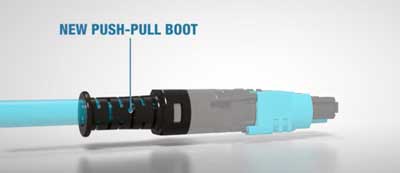
Panduit, the company that first introduced gender and polarity changing
to the MPO connector has improved the design again. Now it has a smaller
connector body, better for dense panels, and a push-pull book that
simplifies insertion and removal.
Learn More (Video)
Caddy Clip Simplifies Installing Cables Under Wire Cable Racks
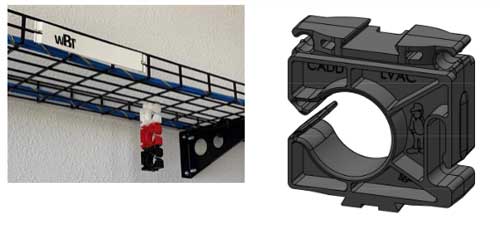
We always warn people about installing fiber in the same cable trays as
copper. Hanging it below the cable tray is much better. The Caddy nVent
Low Voltage Accessory Clip makes it easy. Read more.
Measuring Loss - Displaying dB As A Positive Number - Update
After noting the way the fiber optic meter in a photo sent by a
reader displayed loss, we thought it would be interesting to check some
more meters to see if they worked the same way. So here is a test we
conducted:
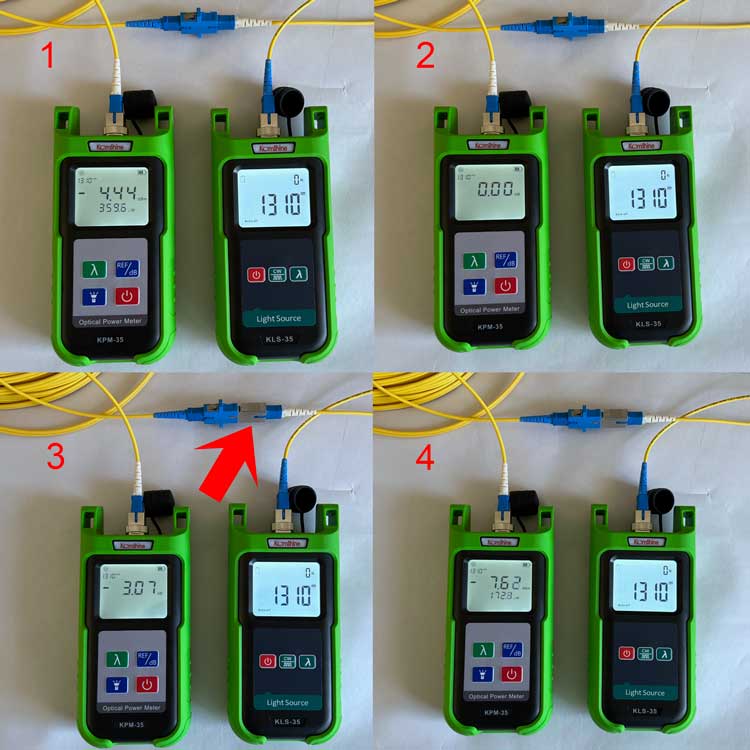
1: Meter and source set up for test. Meter reads -4.44 dBm and 359.6 microwatts in dBm mode
2: Meter changed to dB mode and zeroed
3: 3dB attenuator inserted in connection (arrow). Meter shows -3.07dB
4. Meter changed to dBm mode, shows -7.62 dBm and 172.3 microwatts.
So not all fiber optic power meter makers change loss to be a positive number, which can be confusing.
Measuring Loss - Displaying dB As A Positive Number- March 2022
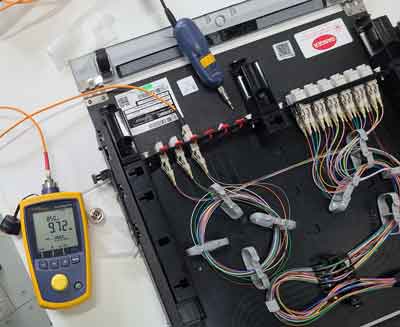
A tech called us looking for troubleshooting help on a cable plant where
it turned out there was damage to the cable. During our discussions, he
sent along this photograph of his setup. We found the photo of the
power meter display interesting in how it displayed loss.
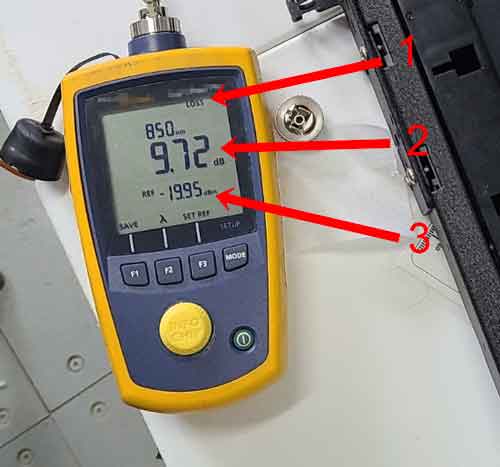
The display clearly says that the measurement is of "Loss" (#1). It also
shows the loss as a positive number (2). Then below the loss it shows
the reference power level "Ref" (3).
Knowing how many techs are confused by dB in measurements, we wonder how
many could figure out the actual power level being measured. Is it
-19.95 dBm + 9.72 dB = -10.23 dBm or -19.95 dBm - 9.72 dB = 29.67
dBm ?
The manual for the instrument says a negative dB loss measurement is
incorrect and offers possible reasons, so what do you do if you want to
measure gain in a fiber amplifier?
Warning For Techs Doing OSP Restoration

FOA recently received an inquiry that was a new one; whether techs
working on restoring OSP links should be concerned about eye safety if
the link used fiber amplifiers. To answer this question, we had to do some research on fiber amplifiers.
The short answer is YES, you should be concerned. The long answer is
more technical and includes details that every OSP tech needs to know.
See "Fiber Amps And Restoration" in the FOA Newsletter Archives..
Try The FOA's Online
Loss Budget Calculator
FOA
has written many articles about loss budgets,
something everyone involved in fiber optics needs to
know and needs to know how to calculate. We've
created a online Loss Budget Calculator that does
the work for you. Just input your cable plant data
and it calculates the loss budget. It works on any
device, especially smartphones and tablets for field
use and even allows printing the results.
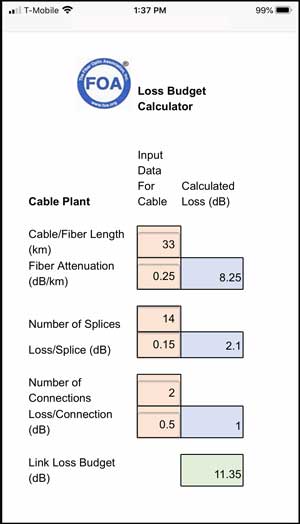
Bookmark
this page (especially on your smartphone): FOA Loss Budget Calculator
Online
|
Worth Reading
Each month we read
hundreds of newsletters and online articles. These
are the ones we think you will find "worth
reading."
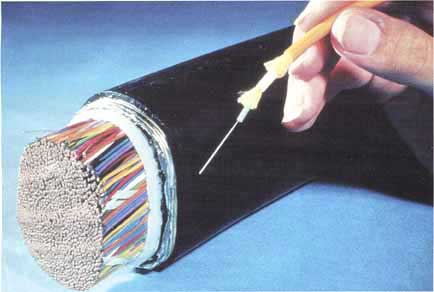 AT&T PR photo from the mid 1970s AT&T PR photo from the mid 1970s
The FOA's History
|
Worth Reading (And
Watching):
May 2022
Google Video On Their Undersea Cables YouTube Slick but interesting video on how undersea cables are designed, built and used.
Corning's Sustainability Report 2021
Dilbert Comic 4/15/22: Wally solves the fiber optic cable supply chain problem
The Indiana Broadband Office is a one-stop-shop for all things broadband in Indiana. State of Indiana guidelines for community broadband projects.
PON Equipment Spending up 32 Percent Y/Y
The Broadband Access equipment market increased 12 percent
year-over-year (Y/Y) from spending on both FTTH PON infrastructure and
fixed wireless CPE.
2022 Submarine Cable Map depicts 486 cable systems and 1,306 landings that are currently active or under construction. Telegeography.
RTI Telecom Magazine from Brazil, in Portuguese. A revista RTI do mês de abril já está disponível online e recomendo a leitura de alguns artigos:
Telestra does restoration after recent Australian floods. Instagram.
Comcast deploys hollow core fiber in low latency, multi-gigabit quest. Light in air goes 50% faster than in glass reducing latency. CI&M.
Ting, a rapidly-expanding ISP, explains how microtrenching helps them install fiber with minimal disruption.
Mississippi Electrical Coops Rapidly Connecting Rural Users. ILSR Community Networks.
April 2022
CENIC Technology Roundtables
- Videos of past webcasts on wIreless and CATV broadband with fiber
coming soon. Some of the best reviews of state of the art technology
from California's state of the art R&D and education network.
Construction Without Disruption - FOA President Jim Hayes' column in ISE Magazine
State of California Middle-Mile Broadband Initiative - California ALL program
Bandwidth Hawk: Big Federal Money Ahead … But Proceed with Caution
- Steven S. Ross | Broadband Communities - Early movers
already see unexpected hurdles as a result of labor shortages,
backordered fiber and electronics, inflation and unforeseen financing
issues. Many are not meeting cash flow projections because they can’t
finish projects on time.
Illinois (and Possibly New York) Poised to Fumble Federal Broadband Funds ILSR Remember the history of incombents getting state laws passed to prevent competition? Well, history repeats itself.
LA County Moves Closer to Municipal Broadband - ILSR Community Networks - WiFi on street lights
March 2022
Every State Has a Chance to Deliver a “Fiber for All” Broadband Future: Electronic Frontier Foundation
CI&M Magazine has a slideshow of bad aerial cable installs in their home area (New Hampshire) and in California (provided by FOA)
New York City: The Case for a Carrier-Neutral Infrastructure
- Broadband Communities - "there is growing momentum for open-access
infrastructure, which allows multiple providers to compete for
customers"
Pew Charitable Trusts has released a couple of new tools for state broadband offices preparing for the influx of federal funding. ILSR
PEW Charitable Trusts has a broadband initiative that aims to help local networks get started.
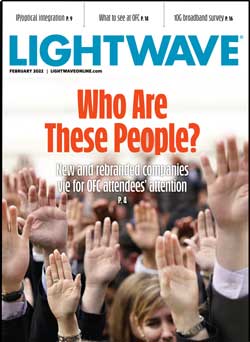
Read the latest issue of Lightwave Covering the OFC Conference, highlights: coherent and 10G PON.
February 2022
Fiber Optics Installed By The Lowest Bidder - ISE Magazine - by Jim Hayes, FOA President.
Building Broadband During Component and Worker Shortages
- Broadband Communities - Completing broadband builds requires
competent fiber optic techs, but training them requires understanding
how they learn - by Jim Hayes, FOA President.
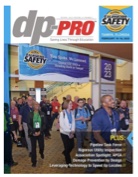
The latest Issue of
dP-PRO, the "call before you dig" magazine, is
online. It's the 2022 Special Locate issue.
New Fiber Optic
Magazine In Spanish
Todo Fibra Optica is
a new digital magazine in Spanish for fiber optics
in Latin America. Jose Enriquez, editor of Todo
Fibra Optic magazine has many years
experience in the fiber optic industry so he knows
the industry well. FOA will be working with him to
share our extensive technical materials in Spanish.

Latest Issue.
Contact:
José Manuel Enriquez Mora, Editor
Todo Fibra Optica LLC
https://todofibraoptica.com/revista-ediciones/
+52 222 302 8224
jose.enriquez@todofibraoptica.com
Lightwave Magazine Is
Back!
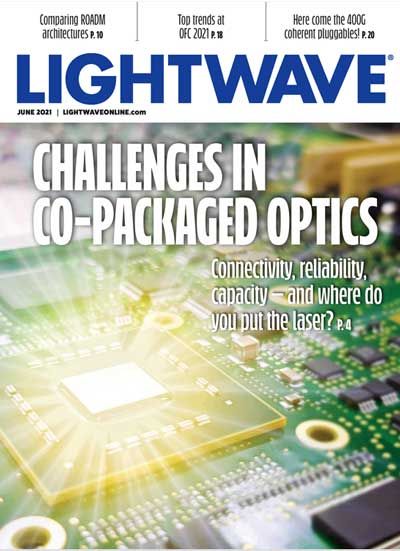
Lightwave Magazine is back
after many years as only a online newsletter.
Lightwave was started in 1984 by Howard Rausch, a veteran
newsman, a gentleman and a scholar! (JH) We reported
on the demise of the printed version of Lightwave in
the FOA
Newsletter of March 2009. Lightwave is back as
a digital magazine, perfect for the times, and still
headed by Editorial Director Stephen Hardy, a
veteran of the fiber optic community with great
in-dept knowledge of the technology, companies and
people who make fiber optics what it is today. Lightwave's comprehensive
website continues too. All very worthwhile reading.
Statistics on US
Labor In Telecom
Eric
Pearson sent us some links to US Bureau of Labor
Statistics data on the US Workforce. Granted it was
updated in May 2019, but has lots of useful and
interesting information on where the work is and
what workers are paid.
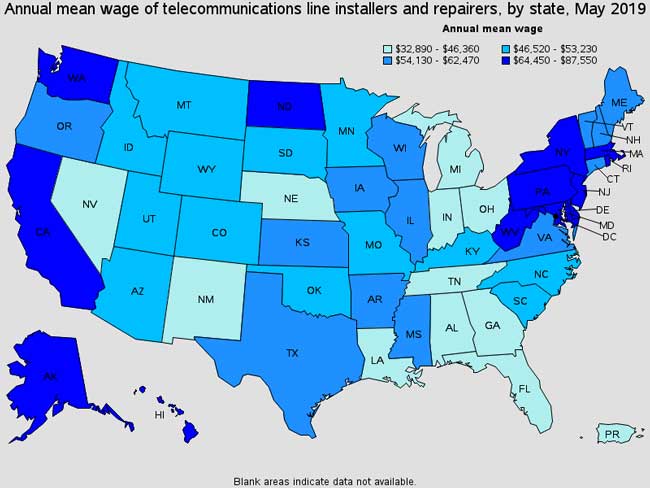
Read
the reports here:
Telecommunications Line Installers
and Repairers (Install and repair
telecommunications cable, including fiber optics.
Telecommunications Equipment
Installers and Repairers (Install,
set up, rearrange, or remove switching,
distribution, routing, and dialing equipment used in
central offices or headends. Service or repair
telephone, cable television, Internet, and other
communications equipment on customers’ property. May
install communications equipment or communications
wiring in buildings.
How Much Does A Cable Installer
Earn? Salary.com
1995-2020
- FOA's 25th Anniversary!
As
part of celebrating 25 years of serving the fiber
optic industry as its primary source of technical
information and independent certifying body, FOA
thought it appropriate to create a short history of
the organization and how it has developed to
help the fiber optic industry. We also wanted to
recognize the contributions many people have made to
the organization over the years that made FOA what
it is today.
The FOA history is now archived on the FOA
website where you can read it anytime or link to
it. Updated
info - dB, total internal reflection and science
projects,
Worth Reading - News
Summary - Past Links Worth Repeating
1983
Video of AT&T's First Test Of A Submarine
Cable System From the AT&T Tech
Channel archives (worth exploring!)
Richard
Epworth's Optical Fiber History from his work
at STL from 1966 with Charles Kao.
Communications Systems Grounding
Rules: Article 800 provides specific
requirements by
Michael
Johnston, NECA Executive Director of
Standards and Safety in EC Magazine
US Broadband Coverage By Service
Provider from the FCC
How
To Build Rural Broadband, Learning From History
In the August 2021
FOA Newsletter, we published a lengthy article on
rural broadband and compared it to rural
electrification in America in the last century.
Much of the comparison was based on an article
written in 1940 by a USDA economist, Robert Beall,
called "Rural Electrification."
If
you are interested in or involved in rural
broadband, we recommend you read the article "How
To Build Rural Broadband, Learning From History"
in the August 2021 FOA Newsletter and
read the Beall article also.
Recycling Fiber Optic
Cable - Contact:
Steve Maginnis
LD4Recycle/ CommuniCom Recycling
(Visit
website)
sm@LD4Recycle.com
803.371.5436
Sumitomo's Ribbon
Splicing Guide - download from
one of the leaders in splicing.
"Who Lost Lucent?: The
Decline of America's Telecom Equipment Industry"
This is a MUST READ for managers in telecom or any
industry!
This long and
well-researched and annotated article in American
Affairs Journal should be mandatory reading
for every high level manager in a telecom company -
or any other company for that matter. To summarize
the article, today, America has no major telecom
equipment company and fears the major suppliers of
equipment who are all foreign, especially the Huawei
from China. This article explains how America got
into this deplorable state.
OFS also has an excellent
website and blog of tech articles worth browsing.
IEC 60050 - International
Electrotechnical Vocabulary - An
extensive dictionary for fiber optics in English and
French. Highly technical - this is one definition:
"mode - one solution of Maxwell's equations,
representing an electromagnetic field in a certain
space domain and belonging to a family of
independent solutions defined by specified boundary
conditions"
If you are interested in restoration -
aren't we all? - you should also read this
article in dpPro magazine by FOA President Jim
Hayes: Damage Protection Requies
Looking Overheas As Well As Underground
- dpPRO Magazine - about the problems with
aerial cables. His previous article for the
magazine was New Techniques for Fiber
Optic Installation.
How much fiber optic cable is
manufactured each year? CRU Reports -
unsurprisingly China is by far the largest market
today
The Institute for Local
Self-Reliance weekly newsletter has
lots of interesting articles and links.
The Open Technology Institute at New America just
published “The Cost of Connectivity 2020,”
US Ignite and Altman
Solon issued “Broadband Models for Unserved
and Underserved Communities”
Universal access to broadband
is a cornerstone to a strong economy,
Achieving universal access will require
community partnerships. by Alfreda
B. Norman, Sr. VP, Federal Reserve Bank of
Dallas
FIBER TO THE FARM: The
co-ops that electrified Depression-era farms are
now building rural internet. Be sure to check out
the high-tech equine installation equipment.
Next Century Cities Newsletter
- News from cities around the US
including Detroit and New York plus small
Infrastructure Get Some
Respect, NY TImes "On Tech"
"The magic of the internet requires a lot of
very boring stuff behind the scenes. "
DIRT
Report On Damage To Utilities Common Ground
Alliance (CGA) annual DIRT report provides a
summary and analysis of the events submitted into
CGA’s Damage Information Reporting Tool (DIRT) for
the year 2018. The complete report is available
for download here. In addition,
there is an interactive dashboard that
allows users to filter the data more by
factors contributing to damages.
Structured Cabling News
- a website and weekly newsletter about cabling.
The Internet Master
Plan for New York City.
The New York City Internet Master Plan is a
comprehensive framework for the infrastructure
and services that provide connectivity to New
York City residents and businesses. This
Master Plan will guide City actions and
public-private partnerships to transform New
Yorkers’ access to this essential
infrastructure for generations to come.
Fiber Trivia From
Corning.
The
Future Of Work Is Skills - So Stop Worrying
About Degrees - The
reality is the future of work is about skills, not
just degrees. (FOA Newsletter Feb 2020)
The job market is hot. So why
are half of U.S. grads missing out?
VIAVI Books On
Fiber Optic Testing (2 volumes) - They're back!
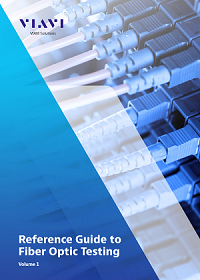 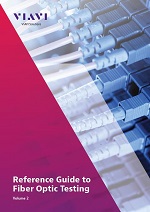
Besides
the FOA reference materials, two JDSU/VIAVI
textbooks, Reference Guide to Fiber Optic Testing,
Volumes 1 and 2, were used as references for
some of the FOA courses and are recommended for
instructors and students. The books are available
from VIAVI as eBooks and the everyone should
download them and recommend them to others.Download
yours now. Volume 1. Volume 2. Viavi Books
Ciena's Submarine Cable
Handbooks (4 to download)
Guidebook To MPO
Testing OptoTest
offers this complete guide to MTP®/MPO testing. In
this guide, you will learn all there is to know
about the different test methods, equipment
options, troubleshooting, and best maintenance
practices to ensure that you have the best testing
experience. Go here to download the book.
50th Anniversary of The
Development of Low Loss Fibers A history
of the development of low loss fiber, a fascinating
story by Jeff Hecht on the OSA (Optical Society of
America) website.
How OFS Makes Fiber
Interesting YouTube video on how fiber is made.
Perhaps a little too much "show biz" but
fascinating. If you have ever seen fiber
manufacture, look at this video. You will be amazed
at how big preforms have become!
How Nexans Makes Copper Cables
- compare the process to fiber - don't most of the
machines look similar?
The True Cost of Telco Damages
(what backhoe fade or target practice can
cost)
Rural Electric Cooperatives:
Pole Attachment Policies and Issues, June 2019.
Clearfield-FOA Certification
Training Clearfield is now offering
their customers an FOA
CERTIFICATION course. This course
provides a basic understanding of fiber optic
technology, as well as Clearfield product
knowledge and how Clearfield’s integrated product
systems work together in a fiber network.
Substandard Contractors - Fiber
Optic Knowledge Doesn't Always Trickle
Down (EC Mag)
Another Source Of
Articles On Fiber
FOA
President and editor of this newsletter Jim Hayes
has also been writing a column in Electrical
Contractor Magazine for almost 20 years now.
Electrical contractors do lots of fiber work and
this column has covered some topics they are
interested in including installation processes,
network design, fiber applications and a lengthy
series on dark fiber - what it is, how's its used
and how it benefits the growth of communication. A
recent web site redesign makes it easier to browse
all these articles - just go to http://www.ecmag.com/contributing-authors/jim-hayes
and you can see all of them. |
Q&A
When readers ask us questions, we genrally refer them to FOA
resources where they can find the answer to their question and many
more. We first send them to the FOA Guide
which is the table of contents for the FOA technical resources. There
they can find pages indexed by topic and a search engine for the FOA
website. It also links them to FOA videos and courses on our free online learning site Fiber U.
The FOA
Fiber FAQs Page (FAQs = frequently asked
questions) gathers up questions readers have
asked us (which first ran in this newsletter)
and adds tech topics of general interest.
|
Good Question!
Tech
Questions/Comments From FOA Newsletter Readers
May 2022
Designations For Fibers
Q: I'm currently working on a project involving optical fiber
with VMS signs, CCTV cameras and other ITS equipment. I was wondering if
there is a standard or a good practice which describe the typical
assignation for each optical fiber on a 6 fibers cable for
example? By that, I mean :
- fibers number 1 and 2 : VMS;
- fibers number 3 and 4 : CCTV;
- fibers number 5 and 6 : spares
A: There are several ways people assign polarity on duplex links.
The way you suggest is the most common I believe. Use the odd number
fibers to transmit in one direction, even number fibers to transmit in
the other direction and document the color codes.
Storing Fiber Optic Cable On Reels
Q: is there a "standard" for how to store a fiber optic cable reel?
A: This is another detail that has not in my knowledge ever been
included in a standard. However manufacturers usually put a note on the
reel to keep it upright - standing on the edges of the spool sides, not
flat on one side of the spool. If the fiber is to be stored for a
period of time, it should be stored in a cool dry place and the ends
sealed with electrical tape.
(Photo storing cable on reel)
Optical Power Of FTTH Signals
Q: I wanted to know on a fiber to home what is the optimal signal
strength I should receve at? I have a leg that is 21 km long I
receive at 1490 at -22 dBm is that to low, everything looks good on my
traces
A: The specifications for GPON are here. https://foa.org/tech/ref/appln/FTTH-PON.html
The standard for GPON calls for receiver power at -13dBm max to -28dBm minimum, so -22 dBm is OK.
April 2022
850 LED Test Source
Q: I need to test multimode fiber at 850 nm but sources are hard to find and expensive. Can I use a laser?
A: Multimode
fibers should be tested with an LED. Lasers have several problems in
multimode fiber that may cause untrustworthy readings. The problem is
that LEDs are no longer used for transmission systems; every MM system
now uses VCSEL transmitters, a surface emitting laser. As a result most
LEDs at 850nm for MM have gone out of production. Two engineers I know
who have been looking for them say there is now only a few sources and
the price is much higher that of a few years ago. We've been buying used
test sources on eBay for training.
105 Micron Fiber?
Q: I have a customer asking about 105um fiber. Does it exist? What is it basically used for? After FOA suggested a clarifying question to the customer: The
fiber is for Power over Fiber(PoF). The construction is 105um fiber
with 125um cladding. The question or assumption would be – The
termination would be the same as 50,62.5 or 8.3um with a 125um cladding?
A: The people who do laser surgery and power over fiber
use special step index fibers and SMA connectors. The power density can
be very high so the heat can build up in the cable. SMA connectors or
the metal ferrule swaged-on connectors are often used for their
all-metal construction with the ability to withstand heat and sometimes
the need to be drilled for special fiber diameters. Because of the high
power, the polish needs to be low reflectance, so we’d recommend using a
wet polish and end with a very fine polishing film - 0.3 microns or so.
Like polishing SM for DWDM.
Cleanliness is very important for these applications. I remember a call
from a doctor doing laser surgery who kept ruining cables because they
were dirty and the high power literally exploded the dirt and pitted the
ends. When that happens, sometimes they can be polished out but often
they are ruined. The same thing happened to the 120 inch telescope at
Lick Observatory when Joe Wampler tried using it to laser range to the
retroreflector Apollo 11 left on the moon. Exploding dust pitted the
aluminization on the mirror.
Gel Leaking From cables
Q: We have several instances where gel from inside
the fiber optic cable has leaked into the splice closure. I have seen
some information about sealing the ends of cables so that this doesn’t
happen but cannot find a specific method or procedure for this or what
to use for a sealant. Is this something that is common practice for
outside plant cables? The gel creates a mess and definitely makes
reentry for additional splicing more difficult. If there is a way to
prevent or minimize this I would like our technicians to start
implementing it.
A: When you install the cable, after inserting the cable
in the splice closure and/or the budder tubes in the splice trays, seal
the end with silicone RTV adhesive. It needs some time to cure but that
should prevent the gel leakage. Or next time, order dry water blocked
cable which will not have this problem.
Single Fiber DWDM
Q: Can you do bidirectional links on a single fiber with DWDM? (Dense Wavelength Division Multiplexing)?
A: A company Called Edge Optical Solutions sells
multiplexers for bi-directional DWDM on one fiber by using
adjacent wavelength channels for each direction. It is good to ~400km
with coherent transceivers but cannot use fiber amplifiers for
repeaters.
March 2022
Maximum Fusion Splice Loss
Q: We have set 0.4 dB as our max for all losses per splice
and my counterparts argue that customer quality will not suffer with a
1.0db-1.5db loss at a splice. What do you think?
A: We would argue that the issue with high loss splices is more
one of reliability. Most fusion splices of singlemode fiber are 0.05 to
0.1 dB A splice that has more than ~0.2dB loss probably has some
inclusion (dirt that got on the fiber after cleaving) or an air bubble
with means the splice is deficient in strength and may fail over time.
If the network is operating at high power with WDM and fiber amplifiers,
the inclusions or bubbles may produce heat which can cause failures. At
very high speeds or using coherent communications over long lengths, it
might affect dispersion.
Another Way Of Expressing dB?
Q: Just wondering what to
think about presenting dBm as a percentage of power, using either a
linear measurement or quadratic equation ?
I recently came across this article : [https://lnkd.in/eYkfpHzD] I
realise it's Wi-Fi signals here, but can you compare this to anything
concerning optical loss or gain , given we're still using dB and dBm ?
A: I had to read this 3 or 4 times to get the idea. Basically
he suggests converting dB, a nonlinear log scale, to a linear scale
expressed in %. Following his steps (assuming I understand his system) ,
100% = 0 dBm (1mw), 90% = -10dBm = 1/10mw = 10% of the original
signal, 80% = -20 dBm = 1/100 mW = 1% of the original signal.. So 80% =
1% of the original signal. And that’s where it seems a bit nonsensical.
70% would be 0.1% of the original signal,,,
We fail to see what this “new math” accomplishes.
OTDR AutoTest
Q: Would we say that OTDR 'Smart' test capabilities are commonplace on newer models or only on some manufacturers meters ?
Maybe it's additional software that can be thought of as an upgrade ?
A: Some form of “auto test” has been available on most OTDRs
for 20 years or more. Early versions were not very good; they usually
just made a test under some average test conditions and reported the
results. Modern OTDRs use more powerful computing power to make several
tests and determine which conditions are best for the fiber being
tested. By optimizing the range, pulse width, number of averages, etc.
it can usually produce fairly good results. We don’t think the cost of
the OTDR is an issue for new ones because users expect all of them to
have a good auto test function. As to whether an older unit could be
upgraded, that would depend on the manufacturer and if they still
support that product. An OTDR less than 5 years old should probably be
able to be upgraded.
February 2022
MM Splice-on Connector On Singlemode Cable
Q: I encountered a situation where a MM
mechanical connector was used on a SM fiber and passed on an OTDR test.
The client and I are interested in understanding how these connectors
could have passed?
A: The joint between a multimode and
singlemode fiber should have vrey high loss, ~17-20 dB, depending on the
mode fill of the MM fiber. However the short length of the MM fiber,
~10mm, might not be enough to cause the modes to fill in the short fiber
in the connector, resulting in relatively low loss.
Eric Pearson, one of the most knowledgeable people on connectors
expressed this idea then tested it with 100m singlemode connected to a
second singlemode cable. The second singlemode cable has an OM3 LC
unicam connector, An EXFO ftb-400 OTDR indicates a 2.09 dB drop. That is
way too much to pass a test but nowhere near the loss that could be
expected from the MM/SM joint. See the OTDR trace above.
November/December 2021
Fiber Optic Color Codes Reference Chart
Q: Has anyone made a fiber optic pocket reference chart that has cable
color orders, frequencies, or other commonly used info on it?
A: The FOA has a page on its Online Guide that covers color codes
(https://foa.org/tech/ColCodes.htm). It is the most popular page in the
FOA Guide! It works great with a smartphone.
Underground Utilities Location
Q: From an OSP engineer: Is there a resource for
underground utilities that we could use on our engineering designs? I
know some counties offer this info but is there a single resource for
all?
A: If you are in the US, the Common Ground Alliance (https://commongroundalliance.com , https://commongroundalliance.com/Tools-Resources/Resources-Library/Toolkits)
is a resource for designers and contractors looking for information on
underground utilities. Their “CGA Best Practices”
(https://bestpractices.commongroundalliance.com) is the best reference
for damage prevention.
Otherwise, the local authorities and utilities are the best source. The
department that issues permits is usually the place to start.
Even with that information, it is recommended that the contractor do
their own search using underground locating equipment before digging.
You may find this page in the FOA Guide on underground cable construction useful. ( https://www.foa.org/tech/ref/OSP_Construction/Underground_Construction.html )
Reflectance
Q: What is the importance of reflectance and all the other numbers in installing and trouble shooting a fiber circuit?
A: Reflectance has always been a secondary issue to connection
loss but has some important issues that need consideration. There are
two basic issues with reflectance, affecting with the output of laser
transmitters and creating background “noise” in a fiber link.
Reflectance can interact with the laser chip itself, causing laser
transmitters nonlinearities or random fluctuations in the output. The
background noise is a secondary issue, but can be seen in ghosts in an
OTDR trace. The light bouncing back and forth in the fiber that causes
ghosts will be added to the signal at the receiver end, adding noise to
the actual signal. Both these effects are more significant on shorter
links, for example FTTH or LANs using PONs (passive optical networks).
We always recommend using APC (angled physical contact) connectors on
short SM links. And most short SM networks do use APC connectors.
FOA tries to stick to the definition that reflectance is the light
reflected from a connection but some others call it “return loss.”
Return loss has been defined generally as the combination of reflectance
and backscatter from the fiber, and that’s how OTDRs measure return
loss. Standards vary in the definition sometimes.
Here is a FOA Guide page on reflectance that gives the basics and
explains how it is tested.
https://foa.org/tech/ref/testing/test/reflectance.html

The
word on the "Dig Once" program is getting out - FOA
is getting calls from cities asking us for
information and advice. Here are some links:
The DoT page on the administration’s Executive
Order: http://www.fhwa.dot.gov/policy/otps/exeorder.cfm
From the Council of State governments: http://www.csg.org/pubs/capitolideas/enews/cs41_1.aspx
From the city of San Francisco: http://sfgov.org/dt/dig-once
An article about Dakota County, MN: https://muninetworks.org/tags/tags/dig-once
And the
one to download and hand out:
A “How To” Guide from The Global Connect Initiative:
https://share.america.gov/wp-content/uploads/2016/04/6.-GCI-Dig-Once.pdf
Is There A Standard
For Fiber Optic Installation?
Another
question we get often is "Is there a standard for
fiber optic installation." The answer is yes, but
not from the usual standards groups you might
expect. Over 20 years ago, the National Electrical
Contractors Association (NECA) asked FOA to help
create a standard for installation. That standard,
ANSI/NECA/FOA-301 has been updated three times
already and is about ready for another update.
Unlike most of those groups who charge you a fortune
for standards, FOA covers the cost so ANSI/NECA/FOA-301
is available free from FOA.
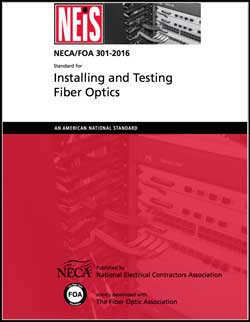
Download your free copy of ANSI/NECA/FOA-301
here (PDF)
Older
questions are now available here.
|
Training / FiberU
News and resources to help you learn more and stay
updated.
Find a
listing of all the FOA-Approved schools here.

Free online
self-study programs on many fiber optics and
cabling topics are available at Fiber U, FOA's
online web-based training website.
Free online training at
Fiber U
The FOA has >100
videos on  |
FOA Network Of
Approved Schools Continues To Grow
The
need for more fiber optic networks to support
broadband and wireless/5G networks has led to a
strong demand for more trained and FOA-certified
techs, and that has led to a demand for more
training organizations. FOA has been adding new
schools and certifying new instructors to meet the
demand. Here are two new schools this month and more
added recently.
Schools added
recently:
Arrow For Engineering #774, Amman, Jordan
Team Fishel #399, Virginia
School 398, Telecom Tech, Colorado
School 396 Optconn, Boston, MA
School 395 Fiber Wizards
(Knowledge on Demand LLC)
School 393,
Carolina's Solution Group
School 394,
Tri-County Career Center, Nelsonville, Ohio
School
388: Global Com of Sterling, Virginia, USA
School 389. CWA-JATC Telecom Training Center, San
Jose, CA
School 390 Northern Allied Communications,
Nespelem, WA
School 391 Lewis-Clark State College,
Lewiston, ID
School 392 Wallace Community College, Dothan,
AL
Complete listing of FOA Approved Training Organizations
Need A Fiber Optic Course Onsite? Invite an FOA School To Come To You
FOA often gets inquiries from an organization that
has personnel that needs training in fiber optics. Recent inquiries have
included contractors, a manufacturer of high-reliability products using
fiber optics and a cable manufacturer. In many cases, where there are
several people needing training, FOA can recommend a FOA Approved School
and Certified Instructor who will come to their location to teach a
class. The advantage is of course the savings in travel costs if
the class comes to you, but it also offers the opportunity to customize
the course to fit your needs, even use your equipment or work on your
components, so the training is more relevant to those taking the class.
Contact FOA to discuss the idea of a custom, on-site class to see if it will better meet your needs.
FOA/Fiber U
On-The-Job Training (OJT) Program
The
FOA Fiber U OJT program combines online study at
Fiber U with OJT with mentoring by experienced
co-workers and their supervisor to help new employees
develop into FOA-certified technicians in only
one year. Upon completion
of this program, the trainee will be prepared to
take the exam for the FOA CFOT (Certified Fiber
Optic Technician) and/or CPCT (Certified Premises
Cabling Technician), the most widely recognized
fiber optic and premises cabling certifications in
the industry.
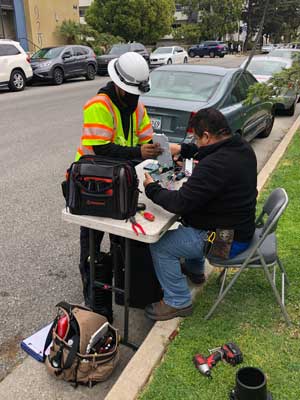
The FOA Fiber U “OJT-To-Cert”
program includes both fiber optics
and premises cabling (copper, fiber & wireless),
so it covers techs working in both outside plant and
premises jobs.
Like other FOA
programs, the OJT-To-Cert program is free. If you
and/or your company is interested in the FOA
OJT-To-Cert program,
contact FOA.
To explain how OJT
works and FOA's OJT-To-Cert program, FOA created a
short 10 minute YouTube video that explains what
OJT is, who uses it and how to use Fiber U to
organize and enhance OJT for new employees and
experienced workers too. Lecture 62: On
The Job Training For Fiber Optics Using Fiber
U
FOA
"Work-To-Cert" Program
Experience Plus
Online Study At Fiber U = FOA Certification
More techs have become comfortable with online
conferences, webinars and training. Many have
discovered that they can become FOA Certified using
their experience in fiber optics and study for the
FOA certification exams online at Fiber U. Thousands of
industry professionals have applied to the FOA
directly for certification without the need for
classroom training, based on their knowledge and
skills developed working the field. Since FOA
certifications are based on KSAs (knowledge, skills
and abilities), current techs already show the
skills and abilities required through their field
experience. FOA provides free online self-study courses at Fiber U for the knowledge
part to prepare you for FOA certification exams
which you can also take online.
If you are an experienced field tech interested in
certification, and FOA is the internationally
recognized certifying body for fiber optics, you can
find out more about the FOA "Work to Cert" program
here.
If you are already a CFOT, FOA also offers many
specialist certifications you can obtain based on
your experience as a field tech. See what's
available at Fiber
U.

Fiber U "Basic Fiber
Optics" Online Self-Study Course Now In Spanish
El curso de
autoaprendizaje en línea "Fibra óptica básica" de
Fiber U ahora en español
El sitio de
aprendizaje en línea de FOA, Fiber U, tiene más de
dos docenas de cursos de autoaprendizaje gratuitos
sobre fibra óptica y cableado de instalaciones.
Como era de esperar, el tema más popular es el
curso "Fibra óptica básica", que se utiliza para
iniciarse en la fibra óptica y como curso de
preparación para realizar el examen de
certificación FOA CFOT.
Ahora el curso básico
de fibra óptica está disponible en español,
utilizando el libro de texto FOA en español, la
sección de la Guía en línea en español y la
capacidad de YouTube para traducir subtítulos de
video al español. El curso funciona exactamente
como la versión en inglés con 10 lecciones, cada
una con cuestionarios y una opción para tomar un
examen de Certificado de finalización.
Para presentar el nuevo curso de
español Fiber U, el examen Certificate of
Completion es gratuito, así que dígaselo a sus
contactos.
Curso Básico de Fibra Óptica
de Fibra U en español.
New Fiber U Course: Fiber Characterization
FOA has added a new course at Fiber U on Fiber Characterization. Fiber
characterization is the process for testing long fiber cable plants for
its ability for carrying high speed communications. With so many
networks now operating at 100, 200, 400 or even 800 Gb/s, fiber
characterization is important, especially on older fiber optic cable
plants.The free Fiber U Fiber Characterization course is available in two forms, as a standalone Fiber U fiber Characterization Course with its own Fiber U Certificate of Completion and as a separate Lesson in the Fiber U Fiber Optic Testing course. This course is recommended for those studying for the FOA CFOS/FC Fiber Characterization certification.
Fiber U MiniCourses: Got An Hour Or Less?
Learn Something New About Fiber Optics.
FOA
has introduced a new type of Fiber U
course, the MiniCourse, a free online course you
could take in a short time, perhaps as you ate lunch
at your desk or took a coffee break. The
topics of these courses should explain what they are
about, and these are all very important topics to
fiber optic techs.
Fiber Optics In Communications
How Optical Fiber Works
Fiber Optic Network
Restoration
Fiber
Optic Connector Identification
Fiber U Color Codes
The Mysterious
dB of Fiber Optics
Fiber Optic Cable Bend Radius
Fiber Optic Link Loss And Power
Budgets
Fiber Optic Connector
Inspection And Cleaning
Fiber Optic Media Conversion
Fiber Optic Cable Midspan Access
Reading An OTDR Trace
Reference Cables For Testing
Fiber Optic Attenuators
The courses have two components, video lectures and
readings, that are complementary. As usual there is
a self-test to allow you to check your
comprehension. As with other Fiber U courses if you
desire, you can take a short test for a Fiber U
Certificate of Completion that costs
only $10.
All these free courses and many more
are available at Fiber U.
What Fiber Techs
Don't Know -
What We Learn From
FOA Certification Tests
As
FOA moves more testing over to our digital online
testing system at ClassMarker, we have access to
more data about our testing, including what
questions and topics on the tests are answered
incorrectly most often. Having this data gives us an
opportunity to evaluate the questions and how they
are stated, but more importantly it allow us to help
our instructors teach the subjects and us to change
our curriculum and online courses to emphasize these
particular topics. These are some of the topics that
we have noticed are answered incorrectly more often
in FOA and Fiber U tests.
Most of the questions missed are on testing.
1. OTDRs - particularly what information is in the
OTDR trace.
2. The difference between dB and dBm
3. Loss budgets - both the concepts and doing the
math
4. Insertion loss testing - single-ended or double
ended for testing patchcords or cable plants, how to
set 0dB references
5. Units of measure - fiber is measured in microns,
wavelengths in nanometers, etc.
At FOA, we're working to add Fiber
U MiniCourses on these topics and working with
our schools to emphasize these topics in their
classes.
If you are going to be taking a FOA certification
course or test in the near future, these topics
should be on your final exam study list.
What We Learn From Hands On Labs
We learn about students performance in hands-on labs
from the feedback of our instructors and our own
experiences too. One big problem is the use of hand
tools. Growing up today, you learn how to use
keyboards, mouses and touch screens, but decades
ago, you also learned how to use basic hand tools.
This is big enough of a problem that we're
considering adding some video lessons on basic hand
tools to prepare students for cable prep,
termination and splicing that require the use of
hand tools.
FOA Guide "Basics Of
Fiber Optics" Now Available Online in Portuguese
(6/2020)

FOA
has now translated the Basics of Fiber Optics
textbook in our Online Guide into Portuguese,
joining Spanish and French translations. For those
speaking Portuguese, we have the technical
information and for schools we also have curriculum
available.
Here is the FOA
Guide in Portuguese,
Spanish
and French
translations.
Time
To Learn - Online
Some
schools have been closed during the pandemic, so FOA
has been working with them to create new online
learning experiences that can in some cases lead to
certification online. FOA certifications are still
based on the KSAs - knowledge from the classroom,
skills from the labs and abilities judged by
instructors or proven by actual experience.
ZOOMing
Much of what we're doing benefits from the
capabilities of "Zoom." Others have created
videoconferencing apps, but none work so well,
especially with limited bandwidth. We've seen remote
labs that have an instructor showing students how to
use the tools they were sent then watching them
duplicate their actions. We have worked out methods
to use Zoom to proctor FOA's online certification
exams.
Blended
Learning
While most FOA schools have suspended in-person
training during this period, some are offering a
"blended learning" option. That means that
students sign up for a FOA certification course,
take the classroom sessions on Fiber U with the
assistance of a FOA certified instructor. Now
online instruction can include reviewing the
labs using the Fiber U Basic
Skills Labs, then when it's possible to attend
classes at the school, complete the hands-on
labs and take the FOA certification exam.
Offline Fiber U
FOA has also created offline Fiber U modules
to allow students with poor or limited
Internet access to use the Fiber U Basic Fiber
Optics and Premises Cabling programs without
Internet access. Contact FOA for information
on using this option.
Online Remote Labs
Alternatively, some schools are experimenting
with "remote labs," where the students get
sent tool kits and components and labs are
conducted by videoconferencing. Before the
labs, the students may watch demos by their
instructor on videoconferencing and/or review
the relevant "virtual hands-on" lessons in the
Fiber U Fiber Optics Basic Skills Labs
so they will already know the steps in the
exercises. And Fiber U has
the new Fiber U
DIY Basic Skills Lab lesson
with directions on how to
purchase inexpensive tools
online and use them to learn
basic fiber optic skills. Videoconferencing
allows the instructor to remotely monitor
their work and provide help as needed. Contact
the FOA for more information.
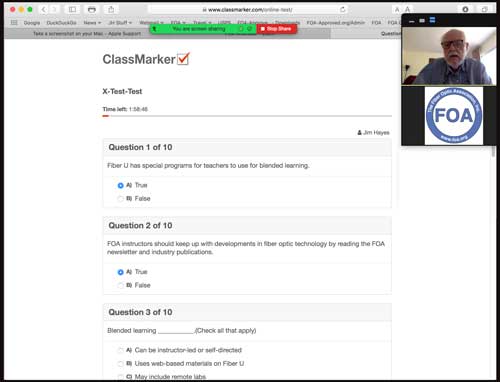
FOA Zoom Exam Proctoring
Online
Certification Testing
FOA has all its certification tests
available online, both for use by our
schools and by our direct "Work
to Cert" applicants. All FOA
certification tests require a proctor to
oversee the applicant taking the exam. In
this time of social distancing, getting a
proctor can be difficult, so FOA now has
procedures for online proctors
administering the exam. Contact
the FOA for more information.
OJT - On-The-Job-Training
Many novices get a job and learn on the job.
They usually have an experienced tech who helps
them gain the knowledge and learn the
skills they need to perform their job. Thinking
about this in relation to the FOA KSAs,
the knowledge, skills and abilities needed by a
fiber optic tech, the tech will learn
skills but not the basic knowledge that helps
them understand the processes involved. FOA can
offer help here with our FOA's
OJT-to-Cert Program,
using our Fiber
U online self-study programs. While the
tech learns on the job, they become a Fiber
U trainee, getting the knowledge they
need, while working under their "mentor" at
work. This is particularly good for
contracting companies who need techs but do
not have the usual training courses
available. Interested in OJT programs? Click
on the link below or contact FOA for
more information.
FOA's OJT-to-Cert
Program

FOA offers free online self-study programs at Fiber U.
Many users are preparing for FOA certification
programs - taking courses at our schools or using
the "Work-to-Cert" program. Some of our
schools are requiring Fiber U programs as
prerequisites for their classroom courses so they
can spend more time on hands-on activities.
FOA School Offers
Toolkit With Online Training
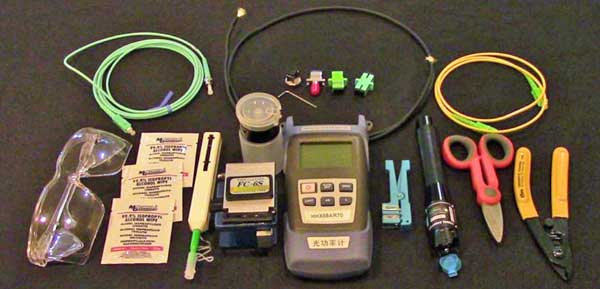
Slayton Solutions
(FOA Approved School #156) is offering a simple
fiber optic tool kit that includes a 29-piece set
of fiber optic tools and a power meter along with
training videos and online instruction for only
$499. 29 Piece Kit includes all tools and devices
a technician needs to install fiber optic
connectors and test optical power. Information on the kit is
available on YouTube. You can contact them for
more information at slaytonsolutions@sbcglobal.net
or https://www.fiberopticsinstitute.com
|
Publications /
Resources

|
More New FOA Video
Lectures On YouTube
Did you know YouTube
will close caption videos in many languages?
Here are directions.
FOA YouTube Video Describes
On-The-Job Training (OJT)
Lecture
62: On The Job Training For Fiber Optics Using
Fiber U
To
explain How OJT works and FOA's OJT-To-Cert program,
FOA created a short 10 minute YouTube video that
explains what OJT is, who uses it and how to use
Fiber U to organize and enhance OJT for new
employees and experienced workers too.
More New Videos
Including FTTH Series
As part of developing the new Fiber U MiniCourses,
we added several new YouTube videos:
Lecture 56 explains the issues of cable bend radius
limitations, typical cable specifications and how to
gage the proper radius or diameter when installing
or storing cable. Lecture 57 covers problems with
dirty connectors and how to inspect and clean them.
4
New Lectures on FTTH - #63-66 Plus #70 on Rural Broadband
New Lecture on Fiber Optics at Electrical Utilities
- #67
FOA Lecture 51 Fiber
Optic Restoration Part 1 - Causes of
Damage To The Network
FOA Lecture 52 Fiber Optic
Restoration Part 2 - Planning For
Restoration
FOA Lecture 53 Fiber Optic
Restoration Part 3 - Troubleshooting
And Repair
FOA Lecture 54 Fiber Optic
Connector Identification - New and old
FOA Lecture 55 The
Mysterious dB of Fiber Optics. -
Understanding dB
FOA Lecture 56 Fiber Optic Cable -
Bend Radius -
Important for Installers to Understand
Like all our YouTube lectures, they are
all short and easy to understand.
Did
you know YouTube will close caption videos in many
languages?
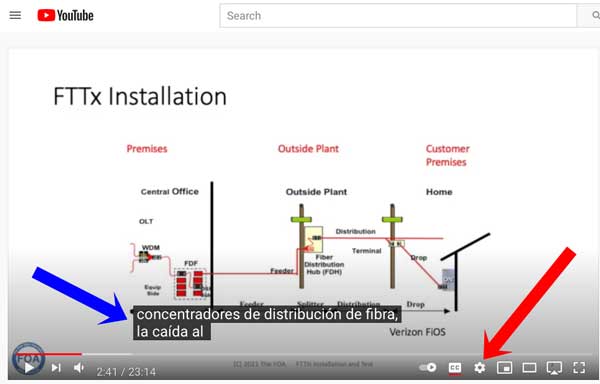
Sign in with Google to get translations for closed
captioning. Click on the settings icon (red arrow.)
Choose "Subtitles". English is the default
language. Click on the arrow after "English
(auto-generated) >". In the new window click on
"Auto-translate" and choose the language you
want.
FOA Loss Budget
Calculator On A Web Page 5/2020
FOA
has written many articles about loss budgets,
something everyone involved in fiber optics needs to
know and needs to know how to calculate. We recently
discovered how to get a spreadsheet ported to a Web
page, so we created this web page that calculates
loss budgets. We have an iOS loss budget app, but
with this web page, you can calculate loss budgets
from any device, smart phone, tablet, laptop, or
desktop computer that has web browsing capability.

Bookmark this page (especially on your
smartphone): FOA Loss Budget Calculator
Online
 We are continually updating the Online Reference
Guide to keep up with changes in the industry and
adding lots of new pages of technical information.
When you go to the FOA
Guide Table of Contents to see the latest
updates - look for
We are continually updating the Online Reference
Guide to keep up with changes in the industry and
adding lots of new pages of technical information.
When you go to the FOA
Guide Table of Contents to see the latest
updates - look for  . .
Recent updates:
FTTH
Updates: Added a section on FTTH Network Design,
updated Architecture and PONs (10G)
Color Codes For Fiber Optics
Fiber
Optic Projects - the FOA Guide to projects from
concept to operation
Coherent Communications Systems in
the FOA Guide.
Go
to The FOA Online Fiber Optic
Reference Guide.
FOA Reference Books
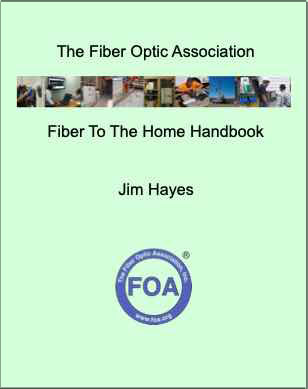
NEW:
FOA's FTTH Handbook: We've
gathered all our information on FTTH from the FOA
Guide and past issues of the FOA Newsletter and
edited it into a 112 page "FTTH Handbook." We even
added a section on planning and managing FTTH
Projects.
The Fiber Optic Association
Fiber To The Home Handbook is
available from Amazon in print and Kindle
editions.
 
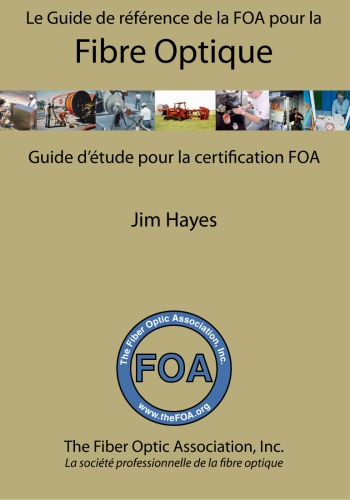      
Fiber Optics (4 languages), Premises Cabling, OSP
fiber and construction, Network Design, Testing and
FTTH
The FOA has it's own
reference books for everyone working in fiber
optics - contractors, installers and end users as
well as for use as textbooks in classes at
educational institutions. They are available as
printed books or Kindle at much lower prices than
most textbooks since we self-publish and sell
online, cutting out the middlemen. Click on the
book images for more information. The Reference
Guide To Fiber Optics is also available in Spanish
and French (print and online) and Portuguese
(online only.)
Click on any book for more information
about it.
FOA
has reprinted

"Lennie Lightwave's Guide"
on its 25th anniversary in a special print
edition.
Lennie
and Uncle Ted's
Guides are online or as free iBooks on iTunes.


Click on any of
the books to learn more.
- Fiber
Optic Safety Poster to download and
print
Resources For
Teachers In K-12 And Technical Schools
Teachers in all grades can introduce their
students to fiber optic technology with some
simple demonstrations. FOA has created a page for
STEM or STEAM (science, technology, engineering, arts
and math) teachers with materials appropriate to
their classes. Fiber Optic Resources For
Teachers.
|
Safety
|
On Safety
FOA
considers safety an integral part of all our
programs, curriculum materials and technical
materials. We start all our textbooks and their
online versions with a section on safety in the
first chapter, like this: Before
we get started - Safety First!
There are pages on the FOA Guide on Safety
procedures Including Eye Safety and. Digging
Safely
And a YouTube lecture: FOA Lecture 2: Safety When Working
With Fiber Optics
In our OSP Construction Section, these pages cover
many safety issues including those related to the
construction of the cable plant: Project Preparation And Guidelines,
Underground Cable Construction,
Underground Cable Installation
and Aerial Cable Installation.
There is even a safety poster for the fiber
activities: PDF Safety Rules For Fiber Optics
The FOA is concerned about safety!
There is a toll-free
"call before you dig" number in the USA: Dial 811
See www.call811.com
for more information
The Common Ground
Alliance has an excellent "Best Practices Guide"
online
- The US Department
of Transportation has a website called "National
Pipeline Mapping System" that allows one
to search for buried pipelines.
Why We Warn You To
Be Careful About Fiber Shards
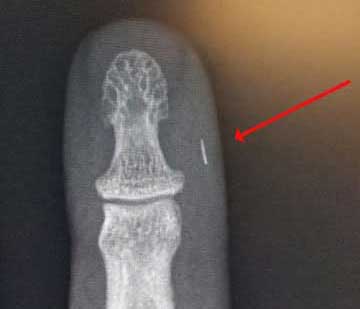
Photo courtesy Brian Brandstetter,
Mississauga Training Consultantcy
Safety Leader
Magazine
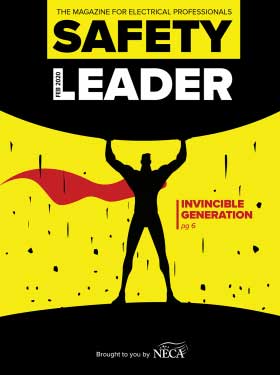
Safety Leader, a new quarterly magazine, informs and
educates electrical contractors on safety from
various angles—electrical, workplace, PPE,
regulations, leadership, line work, NFPA 70E, and
more. Safety Leader is bundled with ELECTRICAL
CONTRACTOR in February, May, August and November. To
receive Safety Leader subscribe to ELECTRICAL CONTRACTOR
magazine here or subscribe to the ELECTRICAL
CONTRACTOR newsletter here.
2022 Conference On
Damage Prevention In Phoenix

Global Excavation Safety Conference
Phoenix AZ
March 1-3, 2022
GlobalExcavationSafetyConference.com:

The magazine, dp-Pro, sponsor of the conference,
has also published it's latest issue with an
article by FOA on "New Construction Techniques
in Fiber Optics" and a overview of the FOA. You can read the magazine here.
When You Bury Marker
Tape, Bury One That Will Work (July 2021)
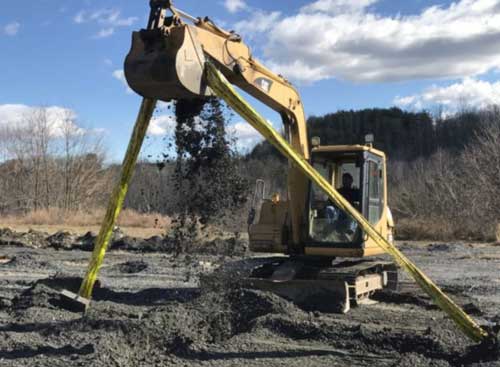
Signaltape® provides a visual
warning by ensuring tape is brought to the surface,
alerting the operator to the presence of a buried
utility. It includes a 3,000-lb. tensile strength
aramid fiber membrane, which ensures the tape is
pulled to the surface to alert the excavation crew.
Signaltape
comes in two sizes: 12″ x 1000′ or 6″ x
1000′.
Best Practices Guide
For Underground Construction
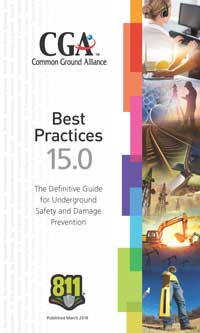
We
assume you are familiar with the "One Call"
and "Call Before You Dig" (811) program, but
are you also familiar "Click Before You Dig.com"
and with the people behind it - the Common Ground
Alliance and their Best Practices website?
Officially formed in
2000, the CGA represents a continuation of the
damage prevention efforts embodied by the Common Ground
Study. Sponsored by the U.S.
Department of Transportation and completed in
1999, this Study represents the collaborative work
of 160 industry professionals who identified best
practices relating to damage prevention. Any best practice or
program endorsed by the CGA comes with consensus
support from experts representing the following
stakeholder groups: Excavators, Locators, Road
Builders, Electric, Telecommunications, Oil, Gas
Distribution, Gas Transmission, Railroad, One
Call, Public Works, Equipment Manufacturing,
State Regulators, Insurance, Emergency Services
and Engineering/Design.
Read the CGA Best Practices Guide
here.
Here are all the CGA resources for
damage prevention.
The
US Department of Transportation has a website
called "National
Pipeline Mapping System" that allows one to
search for buried pipelines.
FOA
Corporate Members - Products & Services
List
of corporate member information provided by FOA
corporate members listed on the FOA website.
|
FOA/About
About The FOA
- Contact
Us: http://www.foa.org
or email <info@foa.org>

FOA has a company page
and four LinkedIn Groups
FOA
- official company page on LinkedIn
FOA
- covers FOA, technology and jobs in the fiber optic
marketplace
FOA
Fiber Optic Training - open to all, covers
fiber optic technology and training topics
Grupo de La Asociación de
Fibra Óptica FOA (Español)
|
What is The FOA?
The FOA is a, international non-profit
educational association chartered to promote
professionalism in fiber optics through education,
certification and standards.
Founded in 1995 by a dozen prominent fiber optics
trainers and leaders from education, industry and government as a professional society for fiber
optics and a source of independent certification,
the FOA has grown to now being involved in numerous
activities to educate the world about fiber optics
and certify the workers who design, build and
operate the world's fiber optic networks.
Read More
FOA History
FOA Timeline of Fiber Optics
FOA was 25 years old
July 2020 - Read about FOA's history
Learn
More About FOA's History.
Contact
Us
The Fiber Optic Association Inc.
http://www.foa.org or email
<info@foa.org>
The
FOA Home Page

Want to know more about fiber optics? Study
for FOA certifications? Free
Self-Study Programs are on "Fiber U®."
Looking for specific information? Here's the largest
technical reference on the web: The
FOA Online Fiber Optic Reference Guide.

Free online self-study programs
on many fiber optics and cabling topics are
available at Fiber U,
FOA's online web-based training website.
|
-
Contact Us
The Fiber Optic Association Inc.
http://www.foa.org or
email <info@foa.org>
- Phone:
1-760-451-3655
The FOA Home Page
Fiber Optic Timeline
(C)1999-2022, The Fiber Optic Association, Inc.
|
FOA Logo
Merchandise
New FOA Swag! Shirts,
Caps, Stickers, Cups, etc.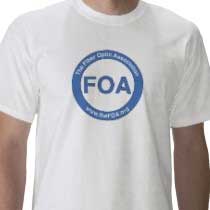
The
FOA has created a store on Zazzle.com offering lots
of new logo merchandise. It has lots of versions of
shirts and other merchandise with "FOA," "Fiber U,"
"Lennie Lightwave" designs and more so you should
find something just for you! See FOA on Zazzle.
-
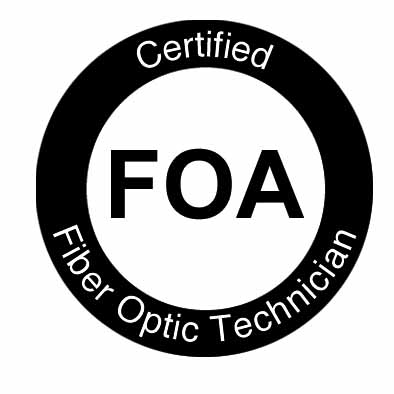
Your
Name, CFOT® - It pays to advertise!
The FOA encourages
CFOTs to use the logo on their business cards,
letterhead, truck or van, etc. and provides logo
files for that purpose. But we are also asked
about how to use the CFOT or CFOS certifications.
Easy, you can refer to yourself as "Your Name,
CFOT" or "Your Name, CFOS/T" for example.
Feel free to use the
logo and designations to promote your achievements
and professionalism!
Contact
FOA at info@thefoa.org to get logos in file format
for your use.
Privacy Policy (for
the EU GDPR): The FOA does not
use cookies or any other web tricks to gather
information on visitors to our website, nor do
we allow commercial advertising. Our website
hosts may gather traffic statistics for the
visitors to our website and our online testing
service, ClassMarker, maintains statistics of
test results. We do not release or misuse any
information on any of our members except we will
confirm FOA certifications and Fiber U
certificates of completion when requested by
appropriate persons such as employers or
personnel services.
Read
the complete FOA Privacy Policy here.
|





































 This is a matter of concern because there is a lot of scrap cable
leftover from new installations and some old cable removed to install
new cable. Much of this cable ends up in landfills, which creates a
problem. Since fiber optic cable is engineered for a long lifetime, 40
years or more, it does not decompose in a landfill in a reasonable time.
That creates a problem for landfills.
This is a matter of concern because there is a lot of scrap cable
leftover from new installations and some old cable removed to install
new cable. Much of this cable ends up in landfills, which creates a
problem. Since fiber optic cable is engineered for a long lifetime, 40
years or more, it does not decompose in a landfill in a reasonable time.
That creates a problem for landfills. 






















 .
.








